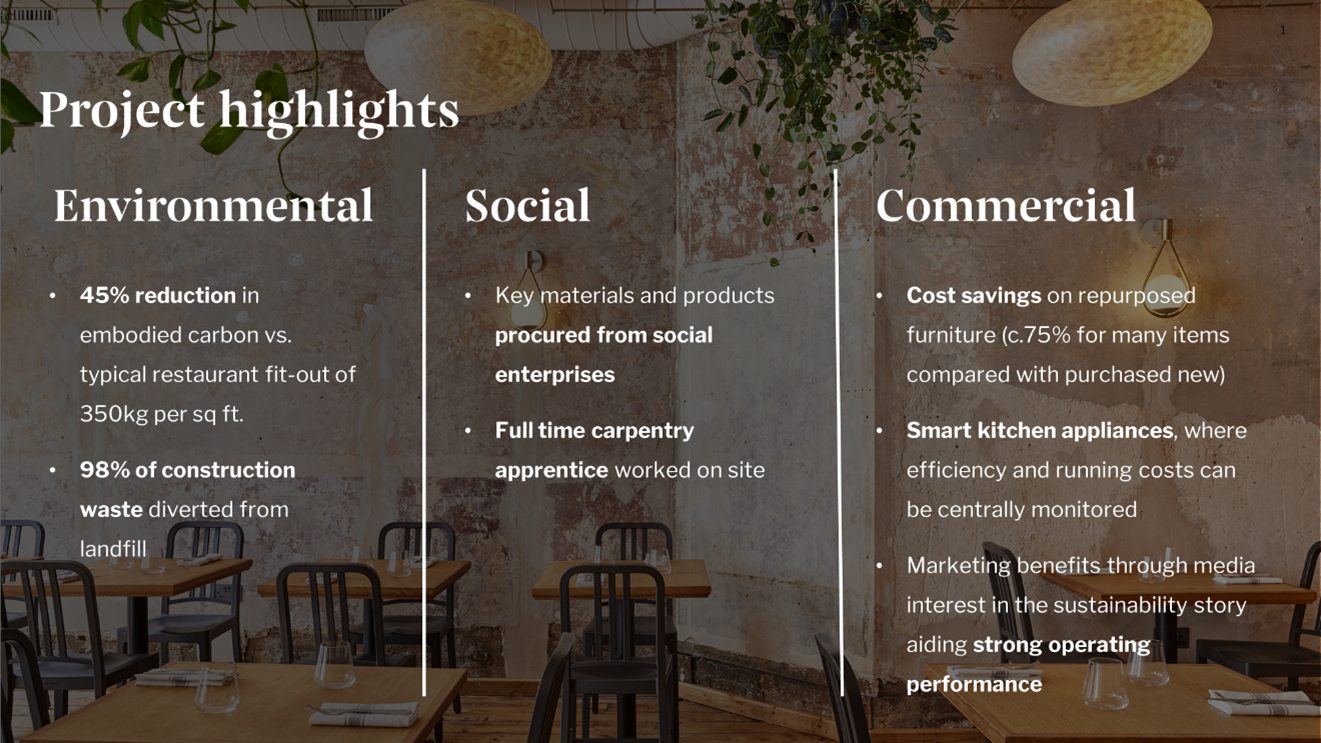Sustainable fit-out for Apricity, Mayfair
Retail and restaurant fit-outs can create a lot of waste and regularly use unsustainable materials in their design.
According to DEFRA, Construction, Demolition and Excavation waste accounts for 62% of the total waste generated in the UK. The average restaurant has a lifespan of only 5 years and in 2020/21 one in ten UK restaurants closed, totalling 8,560. Sometimes parts of the previous fitout (the physical interior and exterior fixtures and fittings) will be repurposed by a new operator, but more often the inflexibility of the previous design will mean that the majority will need to be removed and a new design installed, regularly using unsustainable materials in their construction.
In 2021, global resource use hit a record high with 101.4 billion tonnes of virgin resources brought into the world’s economic system, accounting for over 70% of the world’s carbon emission. Only 8.6% of resources consumed were circular in nature, i.e. they were able to be recycled through the system and remain as a high value resource.
Building owners, restauranteurs and designers need to rethink how they design and deliver new fit-outs, placing circularity at the heart of their approach; minimising waste and maximising the use of reused and recycled materials.
To try and address this Grosvenor and Chantelle Nicholson, award winning chef, recipient of a Green Michelin star and former owner of Tredwells, collaborated to create a restaurant that takes a comprehensive approach to sustainability – from its fit-out right through to operations.
The development incorporated circular economy principles from the start using reclaimed materials, recycled fittings and fixtures all responsibly procured.
Click here to see a full walk-through of the new restaurant fit-out to see the specific materials and suppliers that were used during the project.
Project Highlights

Lessons learnt
Measuring impact: the project used Grosvenor’s Sustainable Development Brief to help inform the sustainability metrics for the project. However, due to the small-scale nature of the fit-out compared with a large development, some of the metrics were not relevant.
We are now working to develop a new sustainable fit-out guide with a set of metrics that are specific to fit-outs. This will also help ensure the right metrics can be selected early in the fit-out to allow for accurate measurement of the overall impact of the project.
Benchmarking: it has been difficult to compare this project with other fit outs. We have found a lack of data available on restaurant fit-outs making it difficult to set targets and understand how our fit-out compares with others in terms of carbon, waste etc. We want to work with our occupiers to start creating this baseline and encourage others to make changes to their fit-outs.
Reducing waste to landfill: achieving the high level of waste diverted from landfill was only achieved through early engagement with our waste collection provider so that we could ensure the correct waste streams were available throughout the project.
Be flexible: reusing materials requires the project team to be flexible, creative and take an innovative approach. The methods that were used to reuse certain materials had to be non-standard on this project and the design had to be adaptable to accommodate this (e.g., taking apart a timber staircase and turning it into wall cladding). Being comfortable with variations in cost and time were important to allow for this.
Storing materials: matching when reused materials are available and when they need to be used on the project was not always possible. Grosvenor’s provision of storage space near the site to put materials and furniture when they became available was very important.
Sourcing fixtures, fittings, and furniture: ensure appropriate people have the necessary time to spend on sourcing, and ensure financial resources enable this to happen. We are now looking at setting up a live online noticeboard that could help with contractors getting rid of over ordered materials. We accept that contractors add 10% of their measure onto an order for wastage, a large new office fit out could in theory have enough leftover plasterboard to fit out a small shop.
Embodied vs. operational carbon: this is a difficult balance to strike and was hard to assess during the project. For future projects we would run a carbon assessment earlier in the project so the team could make more informed decisions on the immediate carbon impact of the material versus the carbon emitted during the operation of the restaurant.
Partners involved in the project
Architect | Architect / Designer  | Construction contractor  |
Project manager  | Mechanical & Engineering / Sustainability Consultant  |